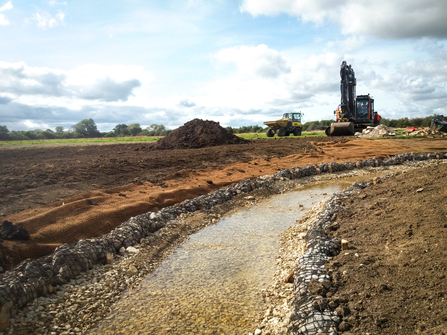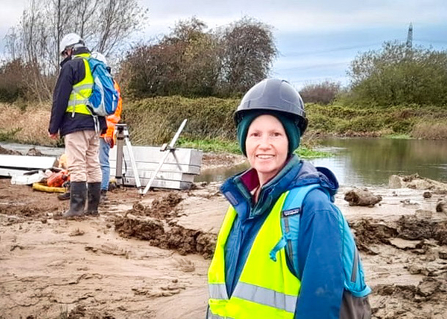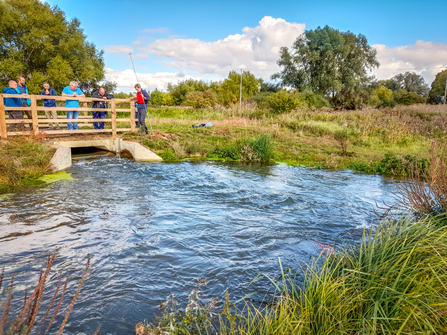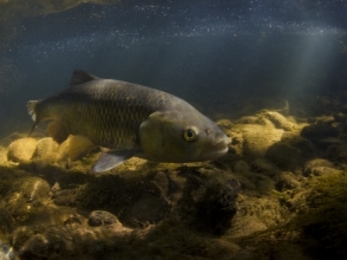New Thames channel reopens river to wildlife in £2m project
An aerial view of the new Thames Channel at Chimney Meadows created by BBOWT as part of its Water Environment Grant (WEG) project. Picture: FiveRivers
A GROUNDBREAKING project to create a new channel of the River Thames and restore long-lost wildlife habitat has been completed.
The 450-metre watercourse in West Oxfordshire bypasses a manmade weir and will enable fish to swim along a 30km stretch of the Thames and spawn for the first time in more than a century.
Created by the Berkshire, Buckinghamshire & Oxfordshire Wildlife Trust (BBOWT) in a £2 million project at its flagship Chimney Meadows Nature Reserve near Bampton, the channel is already being populated by native fish, birds and mammals.
It would be hard to overstate the importance of this project: not only is it an outstanding example of how humans can take huge steps to restore our natural environment and help endangered species, it is also a beacon of hope in the fight against climate change.BBOWT Chief Executive
Working with the Environment Agency, the Trust also created shallow temporary pools called scrapes near the channel. The project has re-established a naturally functioning floodplain habitat which was once common across the UK but was destroyed as rivers were straightened, land was drained and connection with floodplain was lost.
This wetland is now able to store floodwater for longer, helping to protect homes and land from flooding which is predicted to worsen as a result of climate change. The Trust is also working in partnership with Bangor University and the EA who are undertaking research to demonstrate that active floodplains can store carbon and be part of the solution to the climate crisis.
Estelle Bailey, BBOWT’s Chief Executive, said:
"This project is an absolutely amazing achievement for restoring vital habitats for wildlife to move freely while tackling climate change. Our mission as a Trust is to put nature into recovery: we want to see 30 per cent of land in our three counties properly managed for wildlife by 2030, and this is a golden piece of that wild jigsaw puzzle.
"We know we cannot tackle climate change without restoring nature, and this project is a shining example to the whole world of how we can achieve that by working together to bring wildlife back."
The two-year project was funded by a £2 million Water Environment Grant from the EU's European Agricultural Fund for Rural Development (EAFRD). The project was managed by environmental consultancy JCTR, designed by environmental engineering consultancy Atkins and the main contractor on site was Hampshire-based FiveRivers, which delivered all the environmental, wetland and improvement works.

The new Thames channel at Chimney Meadows created by BBOWT as part of its £2m Water Environment Grant (WEG) project. Picture: Pete Hughes
One of the central aims of the work was to create a channel that would bypass Shifford Weir. A structure has existed at this site since the 1890s, when a new ‘short cut’ channel was dug to connect two parts of the Thames and enable easier transportation of wool from the Cotswolds to London. Shifford Weir is owned and operated by the EA and helps with the navigability and flood risk management of the Thames, but blocks the movement of fish. This is one of the reasons that, in recent years, the river environments in the area have been classified as having poor ecological status.
The new channel, in combination with a new rock pool fish pass at Duxford Ford, will allow fish to pass some of the last remaining barriers on the Upper Thames. Fish will now be able to freely swim around the Duxford Loop of the river, even during low water levels, to access some 30km of Thames between Eynsham and Radcot, including 2.1km of potentially good spawning habitat. Crucially, this helps populations of native species including barbel, chub and dace to be far more resilient to environmental change such as hotter, drier summers, and to pollution events.
The new scrapes around the channel will help the nature reserve's curlew - an iconic wading bird with a distinctive downward-curved beak that is in national decline. The curlew is an indicator of the wider health of the wetland, but they need wet pools to feed on aquatic insects and longer grass in which to nest and hide from predators, both of which have been restored.
The project has also attached ‘baffles’ to Great Brook Ford which will further help fish to swim upstream, and planted new, native wet woodland around Duxford Ford, with hundreds of willow, alder, birch and hawthorn trees.

BBOWT Living Landscape Manager for the Upper Thames Lisa Lane at the construction of the new fish bypass channel at Chimney Meadows.
The entire project was overseen by BBOWT Living Landscape Manager for the Upper Thames Lisa Lane, despite the fact that she was diagnosed with breast cancer in the middle of the work.
Lisa, who last year won the Marsh Charitable Trust Leadership Award for her work, started planning the project in 2018, and the work started in December 2019. A year later, she received her diagnosis on Christmas Eve 2020. However, despite beginning treatment, she continued to oversee the project.
Lisa said: "It was really challenging to make this project happen for many reasons and it came close to failing a few times. It would have been quite easy to give up, but I was determined to succeed and kept thinking ‘there has to be a way’.
"I have worked with many people over the years – volunteers, colleagues, funders, contractors and partners – and the development of Chimney Meadows Nature Reserve could not have happened without them. Lizzie Rhymes at the Environment Agency has been a great support in particular, since we first discussed helping fish over or around the various barriers in the river back in 2010! I can't wait to show people what we have achieved."

BBOWT staff removing the final 'stop logs' to fully open the new WEG channel at Chimney Meadows in October 2022. Picture: Lisa Lane
The project was completed last December, but the channel was only partially opened. Now the vegetation has grown up, the Trust has fully opened the channel this month, making it passable for fish. The team will now monitor the numbers of fish and other species that the project was designed to help in order to demonstrate the success of the work. Already, green sandpiper, lapwing and curlew are feeding along the channel and wildfowl such as teal and wigeon have made use of the new scrapes. They have also found water vole prints and otter droppings at the entrance of the new channel.
Estelle Bailey added:"It would be hard to overstate the importance of this project: not only is it an outstanding example of how humans can take huge steps to restore our natural environment and help endangered species, it is also a beacon of hope in the fight against climate change.
"When we have the data to demonstrate just how successful the work has been for local wildlife, this project can become a template for similar schemes across our region and beyond. We need more nature everywhere and we hope this project will inform and inspire generations of conservationists who will go on to save the natural world from threats it now faces."
Editor's notes
Chimney Meadows is a 308-hectare nature reserve, and the only BBOWT reserve to span the River Thames. Part of the site is classed as a Site of Special Scientific Interest (SSSI) primarily for its species-rich grassland. The Trust purchased the first portion of the site, former farmland to the north of the river, in 2003 after raising the funds through a public appeal. In 2017 the Trust purchased a second portion of land on the south side of the river, known as Duxford Old River, following a second public appeal. It is on this part of the site that the new channel and associated scrapes have been created. As well as curlew, the site is home to snipe, great white egret, little egret, harvest mice, hobby, cuckoo, otters, water voles and brown hares and large numbers of wildfowl such as teal and wigeon, especially when flooded over winter.
Project partners: FiveRivers is a specialist in the consultation, design, delivery and monitoring of ecological and environmental solutions, based in Hampshire. Atkins is a world-leading design, engineering and project-management consultancy specialising in infrastructure. JCTR is an environmental consultancy firm based in Wallingford, Oxfordshire. These three companies closely to deliver the Chimney Meadows project for BBOWT. Find out more at five-rivers.com/case-study/chimney-meadows-wetland-restoration-fish-passage.












